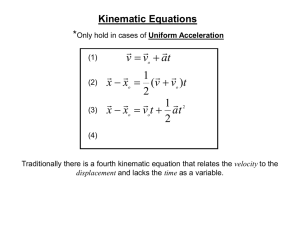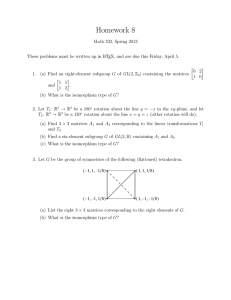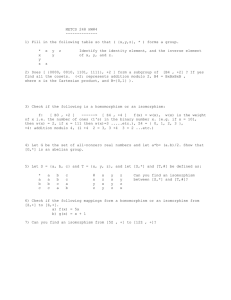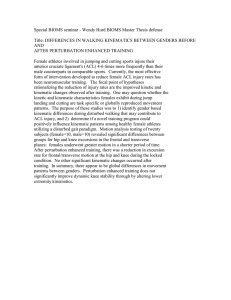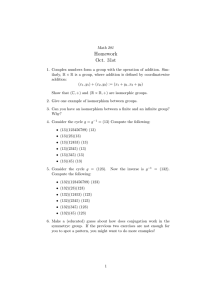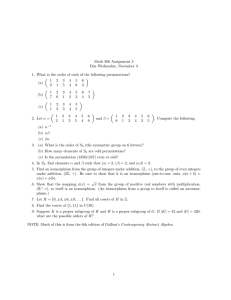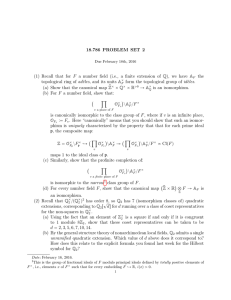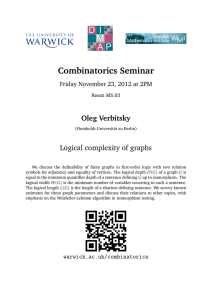IRJET-Detection of Isomorphism in Kinematic Chains: A Review on Methods Applied
advertisement
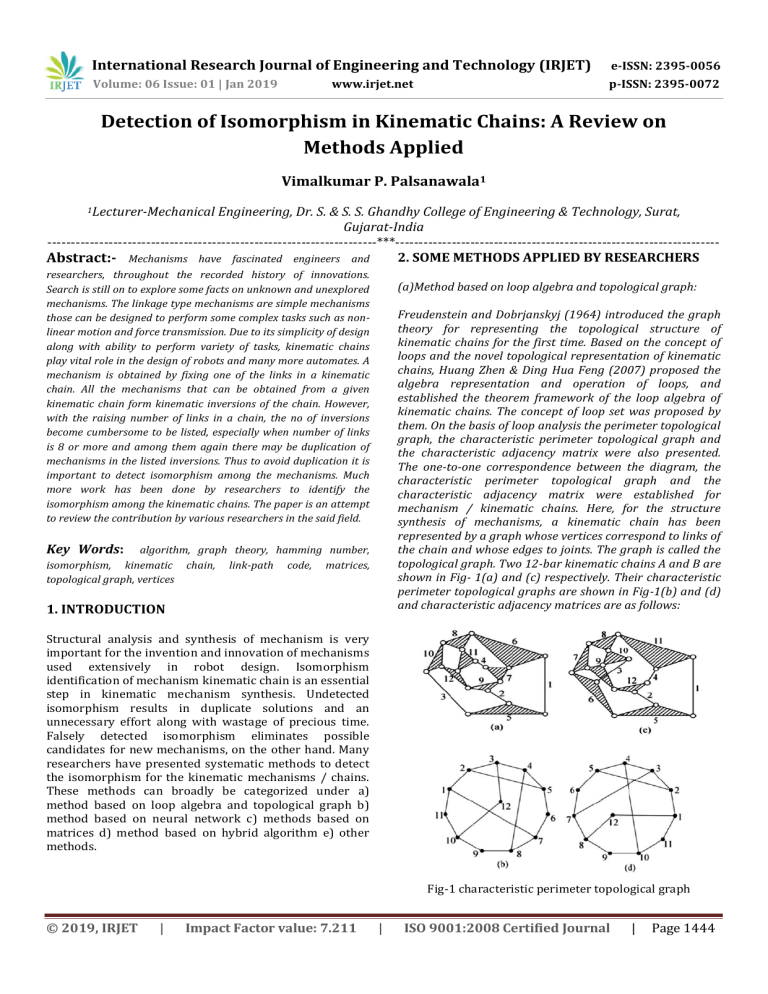
International Research Journal of Engineering and Technology (IRJET)
e-ISSN: 2395-0056
Volume: 06 Issue: 01 | Jan 2019
p-ISSN: 2395-0072
www.irjet.net
Detection of Isomorphism in Kinematic Chains: A Review on
Methods Applied
Vimalkumar P. Palsanawala1
1Lecturer-Mechanical
Engineering, Dr. S. & S. S. Ghandhy College of Engineering & Technology, Surat,
Gujarat-India
----------------------------------------------------------------------***--------------------------------------------------------------------2. SOME METHODS APPLIED BY RESEARCHERS
Abstract:- Mechanisms have fascinated engineers and
researchers, throughout the recorded history of innovations.
Search is still on to explore some facts on unknown and unexplored
mechanisms. The linkage type mechanisms are simple mechanisms
those can be designed to perform some complex tasks such as nonlinear motion and force transmission. Due to its simplicity of design
along with ability to perform variety of tasks, kinematic chains
play vital role in the design of robots and many more automates. A
mechanism is obtained by fixing one of the links in a kinematic
chain. All the mechanisms that can be obtained from a given
kinematic chain form kinematic inversions of the chain. However,
with the raising number of links in a chain, the no of inversions
become cumbersome to be listed, especially when number of links
is 8 or more and among them again there may be duplication of
mechanisms in the listed inversions. Thus to avoid duplication it is
important to detect isomorphism among the mechanisms. Much
more work has been done by researchers to identify the
isomorphism among the kinematic chains. The paper is an attempt
to review the contribution by various researchers in the said field.
(a)Method based on loop algebra and topological graph:
Freudenstein and Dobrjanskyj (1964) introduced the graph
theory for representing the topological structure of
kinematic chains for the first time. Based on the concept of
loops and the novel topological representation of kinematic
chains, Huang Zhen & Ding Hua Feng (2007) proposed the
algebra representation and operation of loops, and
established the theorem framework of the loop algebra of
kinematic chains. The concept of loop set was proposed by
them. On the basis of loop analysis the perimeter topological
graph, the characteristic perimeter topological graph and
the characteristic adjacency matrix were also presented.
The one-to-one correspondence between the diagram, the
characteristic perimeter topological graph and the
characteristic adjacency matrix were established for
mechanism / kinematic chains. Here, for the structure
synthesis of mechanisms, a kinematic chain has been
represented by a graph whose vertices correspond to links of
the chain and whose edges to joints. The graph is called the
topological graph. Two 12-bar kinematic chains A and B are
shown in Fig- 1(a) and (c) respectively. Their characteristic
perimeter topological graphs are shown in Fig-1(b) and (d)
and characteristic adjacency matrices are as follows:
Key Words:
algorithm, graph theory, hamming number,
isomorphism, kinematic chain, link-path code, matrices,
topological graph, vertices
1. INTRODUCTION
Structural analysis and synthesis of mechanism is very
important for the invention and innovation of mechanisms
used extensively in robot design. Isomorphism
identification of mechanism kinematic chain is an essential
step in kinematic mechanism synthesis. Undetected
isomorphism results in duplicate solutions and an
unnecessary effort along with wastage of precious time.
Falsely detected isomorphism eliminates possible
candidates for new mechanisms, on the other hand. Many
researchers have presented systematic methods to detect
the isomorphism for the kinematic mechanisms / chains.
These methods can broadly be categorized under a)
method based on loop algebra and topological graph b)
method based on neural network c) methods based on
matrices d) method based on hybrid algorithm e) other
methods.
Fig-1 characteristic perimeter topological graph
© 2019, IRJET
|
Impact Factor value: 7.211
|
ISO 9001:2008 Certified Journal
|
Page 1444
International Research Journal of Engineering and Technology (IRJET)
e-ISSN: 2395-0056
Volume: 06 Issue: 01 | Jan 2019
p-ISSN: 2395-0072
www.irjet.net
gear mechanism. The two examples are shown in Fig-2
and Fig-3.
Fig-2 Two structure graphs of eight vertexes epicyclic gear
mechanism
Fig-3 Two structure graphs of sixteen vertexes epicyclic
gear mechanisms
Method based on artificial immune algorithm: Zeng et al.
(2008) proposed an artificial immune algorithm to search
the optimal solution for mechanism / kinematic chain
isomorphism identification. AIS have recently emerged as
a computational intelligence approach. Inspired by the
complexity of the immune system, computer scientists
have created systems that in some way mimic or capture
certain computationally appealing properties of the
immune system, with the aim of building more robust and
adaptable solutions. It had been known from many
materials that application areas of AIS techniques at least
include learning, anomaly detection and optimization.
Zeng applied clonal selection principle, which is one of the
three basic theories of AIS, to solve the problem of
isomorphism detection. When the researcher took the
algorithm into simulation, he found that the algorithm
have some limitations and need to be improvised. Then,
the reasons for the limitations were explored and the
algorithm was improvised by adding a process called
saving and updating operator after refreshing operator.
The improvised clonal selection artificial immune
algorithm was taken into simulation and the results
showed that the improvised algorithm had high
robustness and effectiveness. The process of the CSAI
algorithm for kinematic chain isomorphism identification
can be described as following:
CAM(A) ≠ CAM(B), so the two kinematic chains are nonisomorphic.
(b)Methods based on artificial neural network:
Yang et al.(2007), very first time, used “Ant algorithm” to
improve the isomorphism identification efficiency and
reliability for epicyclical gear mechanism. On the basis of
mapping property between graphs, the isomorphism
identification problem can be converted into a matrix
operation problem. Two graphs must be in isomorphism if
the two matrices of the two graphs can be induced as a
same matrix by exchanging their certain rows and
columns. In the other words, two graphs must not be in
isomorphism if the two matrices of the two graphs cannot
be induced as a same matrix by exchanging their certain
rows and columns. A mixed model was developed for
isomorphism identification by integrating the ant
algorithm and mapping property between graphs. The
gratifying results can be achieved while parameters are
selected in appropriate situation by using the model. The
researchers developed a computer program in Visual C++.
Some cases confirm the validity of the model. The work
has been considered as a reliable isomorphism
identification algorithm for intelligent CAD of epicyclical
1) construction of the objective function
© 2019, IRJET
|
Impact Factor value: 7.211
|
ISO 9001:2008 Certified Journal
|
Page 1445
International Research Journal of Engineering and Technology (IRJET)
e-ISSN: 2395-0056
Volume: 06 Issue: 01 | Jan 2019
p-ISSN: 2395-0072
www.irjet.net
2) creation of 20 initial antibodies randomly as the
initial population denoted by pop0, cycle number
loop = 0
3) evaluation of the affinity of each antibody by
affinity evaluation function; if F(x) = 100, then
conclusion can be drawn that the two kinematic
chains are isomorphic.
4) evaluation of the incentive degree of each
antibody and selection of antibodies
5) Cloning of the selected antibodies; production of
the interim population denoted by pop1
6) Mutation; production of the interim population
pop2
7) Retention of N (N is the scale of initial population)
antibodies whose affinity are higher than others;
elimination of all the other antibodies; production
of the interim population pop3
8) Refreshing pop3; production of the new
population denoted by popnew for the next
cycle;loop = loop + 1; if loop = 10,000, then the
cycle is terminated and a conclusion can be drawn
that the two kinematic chains be non-isomorphic;
else skipping to step (3).
Table -1:
The simulation results obtained for solving isomorphic
problems by using the improved CSAI algorithm
(c) Methods based on matrices:
i) Hamming number technique:
Rao and Varada Raju (1991) considered the Hamming
number technique from the information theory for
detection of isomorphism among kinematic chains. The
concept of Hamming number technique and its application
to identify the isomorphism among kinematic chains has
been already reported [Rao and Varada Raju, (1991),
pp.55–75]. From hamming string value for each chain, the
said method identifies the isomorphism. Kartik Pipalia,
Dr.Anurag Verma and Satish Shah(2010) suggested
MATLAB program for finding hamming strings for the
kinematic chains to reduce the calculation efforts and
errors. The researchers described connectivity matrix (fig7), hamming number matrix (fig-8) and hamming string
values for the said kinematic chain shown in fig-6.
And the saving and updating operator can be described as
following:
For (i = 1; i <= N – 1; i++)
{
For (j = i + 1; j <= N; j++)
{
If uniti and unitj have the same alleles in the first three loci,
then eliminate unitj and create a new antibody randomly
to replace unitj
}
}
After improvising the original algorithm, the statistic
results of Fig-4 and Fig-5 are shown in Table I.
Fig-6- 8- link one degree of freedom
Fig-4 A pair of ten link chains
Fig-7 connectivity matrix
Fig-5 a pair of 12 vertices topological graphs
© 2019, IRJET
|
Impact Factor value: 7.211
|
ISO 9001:2008 Certified Journal
|
Page 1446
International Research Journal of Engineering and Technology (IRJET)
e-ISSN: 2395-0056
Volume: 06 Issue: 01 | Jan 2019
p-ISSN: 2395-0072
www.irjet.net
[WPCM]= ({gij}nxn)…………..2
Where gij =(Pij) x (Wij), Wij = ½ [vi/vj+vj/vi], Vi and vj
are the type of ith and jth links connected directly, V = [v1
v2 v3 v4 v5 - - - - vn].
The degree vector (V) represents the degree of
individual link. The degree of link actually represents the
type of link like binary, ternary, quaternary etc. Let d (vi)
=2, for binary link, d (vi) =3, for ternary link, d (vi) = 4, for
quarter nary link, d (vi) =k, for k-nary link.
The form of [WPCM] matrix will be:
Fig-8 hamming number matrix
216, 28,000220111, 26,000231011, 26,000231011,
28,000220111, 28,000220111, 26,000231011,
26,000231011
Fig-9 hamming string value
Considering 2 kinematic chains with 10- bars of class IV
(h) as shown in Fig 10 and Fig 11 in which the binary (n2)
and 5-nary (n5) links are same. WA and WB represent the
[WPCM] matrices of chain 1(Fig-10) and chain 2(Fig-11)
respectively.
ii) Method based on Weighted Physical Connectivity
Matrix (WPCM):
Ali Hasan, R. A. Khan, Ashok Kumar Dargar (2007)
suggested WPCM based method to identify inversions and
the isomorphism for given kinematic chains. The two
structural invariants namely, sum of absolute characteristic
polynomial coefficients [WPCMP] and Maximum absolute
value of characteristic polynomial coefficient [WPCMPmax]
are derived from [WPCM] matrix. These structural
invariants can be calculated using Software MATLAB and
are same for identical or structural equivalent kinematic
chains /mechanism but different for distinct mechanism/
kinematic chains. Also Ali Hasan, Khan R.A., Aas
Mohd(2007) designated the method as Joint Joint Method.
Once the links of the mechanism have been numbered
from 1 to n, [PCM] is defined as a square symmetric matrix
of order n. The elements of [PCM] are entered with either
zero or the type of kinematic pair and defined as:
[PCM] = ({Pij}nxn)………………………1
Where, Pij = Type of kinematic pair between ith link
and jth link that are directly connected = 0, when ith and
jth links are not connected directly. Off course; Pii =0. The
form of [PCM] matrix will be:
For increasing the discrimination power for detection
of isomorphism and identification of degree matrix [DM],
the mutual effect of Wij are introduced into each element of
[PCM] matrix and so [WPCM] is defined as:
© 2019, IRJET
|
Impact Factor value: 7.211
Fig-10 KC-1
|
Fig-11 KC-2
ISO 9001:2008 Certified Journal
|
Page 1447
International Research Journal of Engineering and Technology (IRJET)
e-ISSN: 2395-0056
Volume: 06 Issue: 01 | Jan 2019
p-ISSN: 2395-0072
www.irjet.net
Structural Invariants of Kinematic Chains
(d)
Method based on hybrid algorithm: Yang et al.
(2007) presented a mixed algorithm based on a mapping
property, a genetic algorithm and a simulated annealing
algorithm for the isomorphism detection problem. A
validity encoding scheme was developed by considering
the mapping relationship between two graphs and some
reset measures for the crossover and mutation operators
were developed based on the characteristics in which the
encoding cell could not be reiterated. A simulated
annealing algorithm was introduced into the mixed
algorithm to prevent premature convergence in resolution
and some other measures were developed for improvising
the efficiency, based on the parameter selection. An
example demonstrated by the researchers showed that the
mixed algorithm was a valid algorithm for the
isomorphism identification of kinematic structure graphs
in mechanism design. It was believed to be a reliable
isomorphism identification algorithm for intelligent CAD
and computer-aided manufacturing (CAM).
(e)
Other methods:
(i) Link path code method: Yadav, Pratap and
Agrawal(1995), suggested link path code method for the
identification of inversions and isomorphism in
mechanism/ kinematic chains. In the said method, a new
invariant Link Path Code was defined for a link of a
kinematic chain and the chain itself too. An algorithm was
developed for determining the link-path code for all the
links of a chain. The link-path code is used to identify
structurally equivalent links in a chain, leading to
detection of distinct mechanisms of chain. Algorithm is
shown in Fig-13.
The Structural Invariants (identification numbers) of KC1
and KC2 (using WA and WB matrices) are as follows:
[WPCMP_] of WA (for KC1) = 1.1243e+003
[WPCMP_] of WB (for KC2) = 1.2763e+003
[WPCMPmax] of WA (for KC1) =393.6130
[WPCMPmax] of WB (for KC2) =397.7265
Method reports that chain 1 and 2 are non-isomorphic as
the set of structural invariants [WPCMP] and
[WPCMPmax] are different for both the KCs.
iii) Method based on eigenvectors and eigenvalues: Chang
et al. (2002) introduced the method based on eigenvectors
and eigenvalues. Cubillo and Wan (2005) furthered this
idea. Kinematic chains were firstly represented by
adjacent matrices. By comparing the eigenvalues and
corresponding eigenvectors of adjacent matrices, the
isomorphism of mechanism kinematics chain could easily
be identified. The relationships in the mechanisms could
also be obtained. The theory proposed by Chang et al.
(2002) had been revised, after errors in the original theory
were discovered. Subsequently, the necessary and
sufficient conditions of the eigenvalues and eigenvectors
of adjacent matrices for isomorphic kinematic chains had
been proven rigorously. The new procedure was
developed and presented by them to identify isomorphic
chains. With this new procedure, it was only necessary to
compare eigenvalues and several eigenvectors of adjacent
matrices of isomorphic kinematic chains to detect the
isomorphic chains. Some examples had been provided to
demonstrate how to use the theory in paper published by
the researchers (Cubillo and Wan, 2005) and (S.F.Patil and
S.C.Pilli, 2007). Cubillo and Wan tested their theorem
through an example and their adjacency matrices as
shown in Fig-12.
Fig-13 link-path code algorithm
Fig-12 chains with their adjacency matrix
© 2019, IRJET
|
Impact Factor value: 7.211
|
ISO 9001:2008 Certified Journal
|
Page 1448
International Research Journal of Engineering and Technology (IRJET)
e-ISSN: 2395-0056
Volume: 06 Issue: 01 | Jan 2019
p-ISSN: 2395-0072
www.irjet.net
3. CONCLUSION
The various approaches and methods discussed in the
paper are effective in general in many of the cases .But no
single method can be complete to deal with every case.
The improvement may be needed and new method may be
expected to be developed to detect the isomorphism
among the mechanism- kinematic chain more effectively.
REFERENCES
1) T.S. Mruthyunjaya and H.R. Balasubramanian,
Mech. Mac& Theory 22, 131-139 (1987).
2) J. J. Uicker and A. Raicu, Mech. Mac& Theory 10,
375 (1975).
3) T. S. Mruthyunjaya and M. R. Raghavan, J. Mech.
Des. Trans. ASME 10l, 488 (1979).
4) H. S. Yah and A. S. Hall, J., Mech. Des. Trans. ASME
104, II (1982).
5) E. V. Krishnamurthy. CombinatoricJ and Graph
Theory (Ed. S. B. Rao), p. 18. Springer, New York
(1981).
6) H. R. Balasubramanian and K. R. Parthasarathy.
Combinatorics and Graph Theory (Ed. S. B. Rao),
p. 42. Springer, New York (1981).
7) H. S. Yan and W. M. Hwang, J. Mech. Transm.
Automain Des. 105, 658 (1983).
8) R. K. Dube and A. C. Rao. ASME paper 86-DET-172
(1986).
9) A. C. Rao, Indian J. Tech.26, 105 (1988).
10) A.C. Rao, Indian J. Tech. 26, 155 (1988).
11) A.C. Rao, Raju D. Varada, Application of the
hamming
number
technique
to
detect
isomorphism among kinematic chain s and
inversion, Mech. Mach. Theory 26 (1) (1991) 5575.
12) A. G. Ambekar and V. P. Agrawal, Mech. Mac&
Theory 22, 453-461 (1987)
13) A. G. Ambekar and V. P. Agrawal. ASME DET Conf.
86-DET-169, Columbus, Ohio, Oct. (1986).
14) A. C. Rao and C. Nageswara Rao. Indian J. Tech. 24,
773-776 (1986).
15) A. G. Ambekar and V. P. Agrawal, Mech. Mac&
Theory 22, 453-461 (1987).
16) Ashok Dargar, Ali Hasan and R. A. Khan
Identification Of Isomorphism Among Kinematic
Chains And Inversions Using Link Adjacency
Values IJMM E, Vol. 4 (2009), No. 3, 309‐315.
17) Ding, H. and Huang, Z. (2007) ‘A new theory for
the topological structure analysis of kinematic
chains and its applications’, Mechanism and
Machine Theory, Vol. 42, No. 10, pp.1264–1279.
© 2019, IRJET
|
Impact Factor value: 7.211
|
ISO 9001:2008 Certified Journal
|
Page 1449
